Themed collection Quantum Dots: A Nanoscience Nobel Prize

Technology progress on quantum dot light-emitting diodes for next-generation displays
This article focuses on state-of-the-art technologies used in the research on materials, devices and processes to achieve high-performance QD-LEDs.
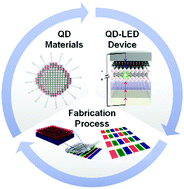
Nanoscale Horiz., 2021,6, 68-77
https://doi.org/10.1039/D0NH00556H
Tin and germanium monochalcogenide IV–VI semiconductor nanocrystals for use in solar cells
This feature article highlights efforts towards achieving synthetic control over non-lead containing IV–VI monochalcogenides and their application in photovoltaic devices.
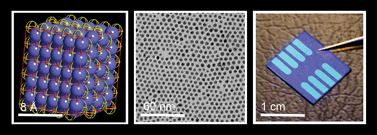
Nanoscale, 2011,3, 2399-2411
https://doi.org/10.1039/C1NR10084J
Mercury chalcogenide colloidal quantum dots for infrared photodetection: from synthesis to device applications
A comprehensive review on Hg chalcogenide colloidal quantum dot infrared photodetectors, with the essential progress of synthesis methods, property control, device engineering, focus plane array integration and innovative applications.

Nanoscale, 2023,15, 6476-6504
https://doi.org/10.1039/D2NR07309A
Biomolecule-derived quantum dots for sustainable optoelectronics
The recent advances in sustainable optoelectronics applications of quantum dots derived from different biomolecules are documented in this review.
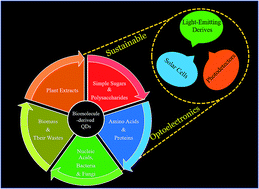
Nanoscale Adv., 2019,1, 913-936
https://doi.org/10.1039/C8NA00332G
Novel properties and applications of carbon nanodots
Overview of the optical properties and versatile applications of carbon dots.
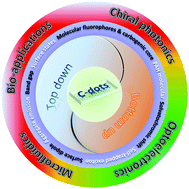
Nanoscale Horiz., 2018,3, 565-597
https://doi.org/10.1039/C8NH00106E
Semicondutor quantum dots-based metal ion probes
This review details the recent progress regarding the state-of-the-art use of semiconductor quantum dots (QDs) as metal ion probes for diverse applications.

Nanoscale, 2014,6, 43-64
https://doi.org/10.1039/C3NR04628A
Focusing on luminescent graphene quantum dots : current status and future perspectives
Recent progress on graphene quantum dots is presented, mainly focusing on the top-down synthetic routes, optical properties and applications.

Nanoscale, 2013,5, 4015-4039
https://doi.org/10.1039/C3NR33849E
Stable continuous-wave lasing from discrete cesium lead bromide quantum dots embedded in a microcavity
We have successfully fabricated a high-Q vertical-cavity surface-emitting laser (VCSEL) using CsPbBr3 QDs, achieving room-temperature lasing with a low threshold of 8.8 W cm−2, demonstrating excellent stability even after a year.
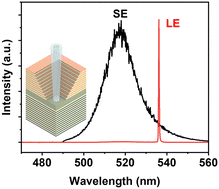
Nanoscale Horiz., 2023,8, 1403-1410
https://doi.org/10.1039/D3NH00139C
Photoinduced interfacial electron transfer from perovskite quantum dots to molecular acceptors for solar cells
Electron donor-acceptor systems between halide perovskites and molecular acceptors form promising p-n junctions for solar cells.
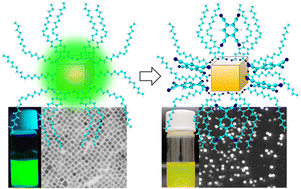
Nanoscale, 2023,15, 7695-7702
https://doi.org/10.1039/D3NR01032E
InP/ZnS quantum dot photoluminescence modulation via in situ H2S interface engineering
High photoluminescent InP/ZnS QDs synthesis by in situ H2S interface engineering.

Nanoscale Horiz., 2023,8, 522-529
https://doi.org/10.1039/D2NH00436D
Determination of the optical constants of ligand-free organic lead halide perovskite quantum dots
We determine the complex refractive index of perovskite QDs, for which we take advantage of a ligand-free synthetic approach that facilitates discriminating the contribution of the nanocrystals to the effective optical constant of the ensemble.

Nanoscale, 2023,15, 2553-2560
https://doi.org/10.1039/D2NR05109E
High-performance tricolored white lighting electroluminescent devices integrated with environmentally benign quantum dots
Tricolored white lighting quantum dot-light-emitting diodes comprising three environmentally benign primary color emitters of II–VI blue and green ZnSeTe and I–III–VI red Zn–Cu–In–S QDs are demonstrated.
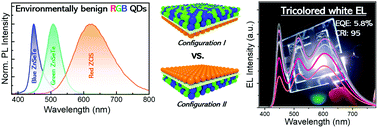
Nanoscale Horiz., 2021,6, 168-176
https://doi.org/10.1039/D0NH00606H
Lead-free, stable, high-efficiency (52%) blue luminescent FA3Bi2Br9 perovskite quantum dots
Lead-free Bi-based perovskite FA3Bi2X9 (X = Cl, Br, and I) quantum dots (QDs) are synthesized for the first time at room temperature. The ligand-passivated FA3Bi2Br9 QDs exhibit blue emission at 437 nm with photoluminescence quantum yield (PLQY) up to 52%.
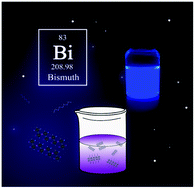
Nanoscale Horiz., 2020,5, 580-585
https://doi.org/10.1039/C9NH00685K
Promoting photoluminescence quantum yields of glass-stabilized CsPbX3 (X = Cl, Br, I) perovskite quantum dots through fluorine doping
Highly luminescent glass-stabilized CsPbX3 (X = Cl, Br, I) perovskite QDs are fabricated via an in situ glass crystallization strategy and fluorine doping.
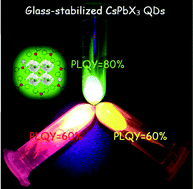
Nanoscale, 2019,11, 17216-17221
https://doi.org/10.1039/C9NR07307H
Au quantum dots engineered room temperature crystallization and magnetic anisotropy in CoFe2O4 thin films
For the first time, this work presents a novel room temperature time-effective concept to manipulate the crystallization kinetics and magnetic responses of thin films grown on amorphous substrates.
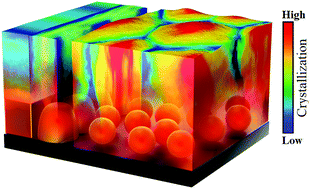
Nanoscale Horiz., 2019,4, 434-444
https://doi.org/10.1039/C8NH00278A
Understanding charge transfer and recombination by interface engineering for improving the efficiency of PbS quantum dot solar cells
In Mg-doped ZnO/PbS QDHSCs, a spike structure is formed between the QDs and the “electron acceptor”, which improved charge collection efficiency.
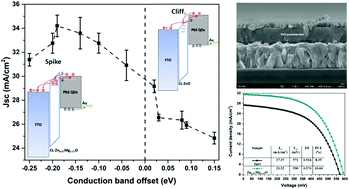
Nanoscale Horiz., 2018,3, 417-429
https://doi.org/10.1039/C8NH00030A
Highly stable CsPbBr3 quantum dots coated with alkyl phosphate for white light-emitting diodes
A simple strategy to synthesize TDPA coated CsPbBr3 QDs with improved stability and high PLQY.
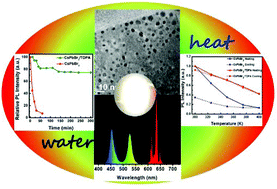
Nanoscale, 2017,9, 15286-15290
https://doi.org/10.1039/C7NR04179A
Perovskite quantum dots encapsulated in electrospun fiber membranes as multifunctional supersensitive sensors for biomolecules, metal ions and pH
Electrospun PMMA fiber membrane encapsulated with CsPbBr3 exhibits excellent FRET detection performance on trypsin, Cu2+ and pH.
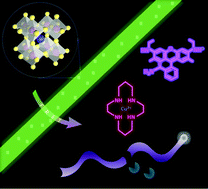
Nanoscale Horiz., 2017,2, 225-232
https://doi.org/10.1039/C7NH00057J
Multistage extraction platform for highly efficient and fully continuous purification of nanoparticles
This paper presents a fully-continuous novel liquid–liquid-extraction (LLE) platform for the purification of nanoparticles.

Nanoscale, 2017,9, 7703-7707
https://doi.org/10.1039/C7NR01826F
Detection of high-energy compounds using photoluminescent silicon nanocrystal paper based sensors
A silicon nanocrystal paper based sensor has been developed for the rapid, on-site detection of nitro-group containing explosive compounds.

Nanoscale, 2014,6, 2608-2612
https://doi.org/10.1039/C3NR06271F
6.5% efficient perovskite quantum-dot-sensitized solar cell
Highly efficient perovskite quantum-dot-sensitized solar cell.
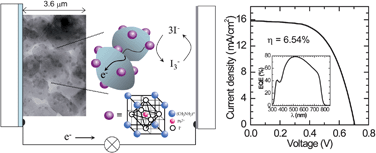
Nanoscale, 2011,3, 4088-4093
https://doi.org/10.1039/C1NR10867K
Ultra-small α-CsPbI3 perovskite quantum dots with stable, bright and pure red emission for Rec. 2020 display backlights
The 4.2 nm α-CsPbI3 quantum dots - polymer composite films with 630 nm emission and high stability have been achieved, which are used for LED displays with color gamut to 96% of the Rec. 2020 standard.

Nanoscale, 2023,15, 1661-1668
https://doi.org/10.1039/D2NR05456F
Photoconductive focal plane array based on HgTe quantum dots for fast and cost-effective short-wave infrared imaging
Image (left) acquired using a camera which active layer is a photoconductive layer fabricated from a HgTe nanocrystal film (schematic on right).
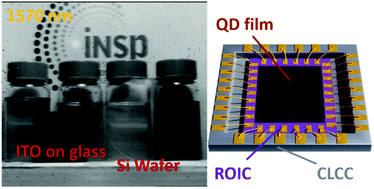
Nanoscale, 2022,14, 9359-9368
https://doi.org/10.1039/D2NR01313D
Highly luminescent red-emitting In(Zn)P quantum dots using zinc oxo cluster: synthesis and application to light-emitting diodes
High quality red-emitting In(Zn)P QDs were synthesized by combining a Zn oxo cluster and seed-mediated continuous growth method.
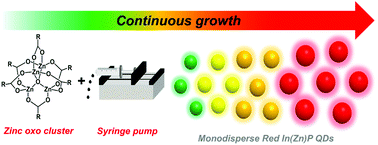
Nanoscale, 2022,14, 2771-2779
https://doi.org/10.1039/D1NR08038E
Quantum dot photolithography using a quantum dot photoresist composed of an organic–inorganic hybrid coating layer
We reports a QD photolithography technique using a custom-developed QD photoresist made of an organic–inorganic hybrid coating layer.

Nanoscale Adv., 2022,4, 1080-1087
https://doi.org/10.1039/D1NA00744K
Surface ligand chemistry on quaternary Ag(InxGa1−x)S2 semiconductor quantum dots for improving photoluminescence properties
The photoluminescence properties of Ag(InxGa1−x)S2 quaternary semiconductor quantum dots are improved by ligand exchange with L-, X-, and Z-type ligands. Analyses of both the quantum dots and byproducts are performed for understanding the mechanism.

Nanoscale Adv., 2022,4, 849-857
https://doi.org/10.1039/D1NA00684C
Photoluminescence investigations of sulfur quantum dots synthesized by a bubbling-assisted strategy
The photoluminescence mechanisms of S-dots were revealed by the bubbling-assisted synthesis and spectroscopic study. The emission color of the S-dots depends on the size, and the emission efficiency is affected by the surface sulfur species.

Nanoscale Adv., 2021,3, 4271-4275
https://doi.org/10.1039/D1NA00282A
Room temperature synthesis of Sn2+ doped highly luminescent CsPbBr3 quantum dots for high CRI white light-emitting diodes
Room temperature synthesis of Sn2+ doped CsPbBr3 QDs show a high PLQY of 82.77% and their corresponding WLEDs exhibit a CRI of 89 and a CCT of 3954.
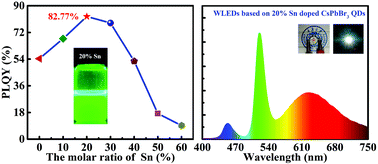
Nanoscale, 2021,13, 9740-9746
https://doi.org/10.1039/D1NR01492G
2D-MoS2 nanosheets as effective hole transport materials for colloidal PbS quantum dot solar cells
Herein, we demonstrate for the first time matrix-free deposition of two dimensional (2D) MoS2 nanosheets as an efficient hole transport layer (HTL) for colloidal lead sulfide (PbS) quantum dot (QD) solar cells.
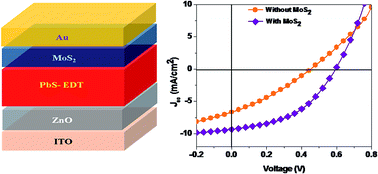
Nanoscale Adv., 2019,1, 1387-1394
https://doi.org/10.1039/C8NA00272J
Stable, small, specific, low-valency quantum dots for single-molecule imaging
Small, specific, low-valency quantum dots for single-cell and single-molecule imaging.
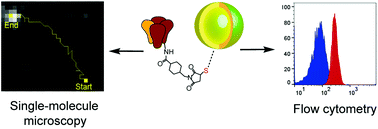
Nanoscale, 2018,10, 4406-4414
https://doi.org/10.1039/C7NR08673C
Novel inorganic perovskite quantum dots for photocatalysis
Uniform CsPbX3 quantum dots were synthesized via an emulsion fabrication and demulsion method at room temperature. The as-prepared CsPbX3 QDs exhibit high synthetic yield and highly uniform morphology, as well as excellent photocatalytic activity toward the degradation of MO.
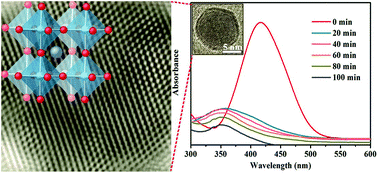
Nanoscale, 2017,9, 12032-12038
https://doi.org/10.1039/C7NR04421F
Efficient quantum dot light-emitting diodes with a Zn0.85Mg0.15O interfacial modification layer
Efficient inverted QLEDs have been developed by using solution processed ZnMgO nanoparticles as an interfacial modification layer.
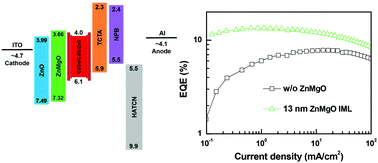
Nanoscale, 2017,9, 8962-8969
https://doi.org/10.1039/C7NR02099F
A facile synthesis of highly luminescent nitrogen-doped graphene quantum dots for the detection of 2,4,6-trinitrophenol in aqueous solution
Fluorescent N-GQDs with a high quantum yield of 59.2% have been synthesized by pyrolyzing CA and Tris-HMA. The N-GQDs emitted strong blue fluorescence under 365 nm UV light and their fluorescence intensity showed a sensitive response to TNP in the range 1–60 μM.
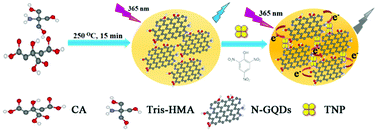
Nanoscale, 2015,7, 1872-1878
https://doi.org/10.1039/C4NR06365A
Edge-enriched graphene quantum dots for enhanced photo-luminescence and supercapacitance
Graphene quantum dots synthesized from activated graphene using ultrasonication and chemical activation shows high edge-enriched states resulting in excellent luminescence and capacitance properties.
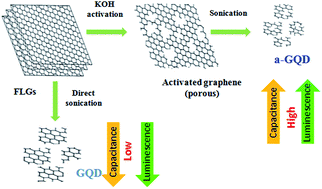
Nanoscale, 2014,6, 11988-11994
https://doi.org/10.1039/C4NR02365J
Highly luminescent S, N co-doped graphene quantum dots with broad visible absorption bands for visible light photocatalysts
A facile hydrothermal synthesis route to N and S, N co-doped graphene quantum dots (GQDs) was developed by using citric acid as the C source and urea or thiourea as N and S sources.
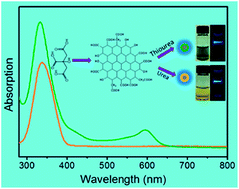
Nanoscale, 2013,5, 12272-12277
https://doi.org/10.1039/C3NR04402E
Aqueous synthesis of highly luminescent AgInS2–ZnS quantum dots and their biological applications
Highly luminescent AgInS2–ZnS quantum dots that can be readily utilized in biological applications have been successfully prepared in aqueous media.
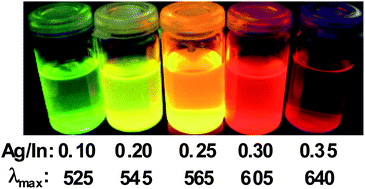
Nanoscale, 2013,5, 2322-2327
https://doi.org/10.1039/C3NR34159C
About this collection
This cross-journal collection in Nanoscale Horizons, Nanoscale and Nanoscale Advances is dedicated to quantum dots, in honour of the 2023 Nobel Prize in Chemistry. This collection showcases both historic papers and recent developments in the field and includes work focusing on the design, synthesis/characterisation and varied applications of quantum dots.